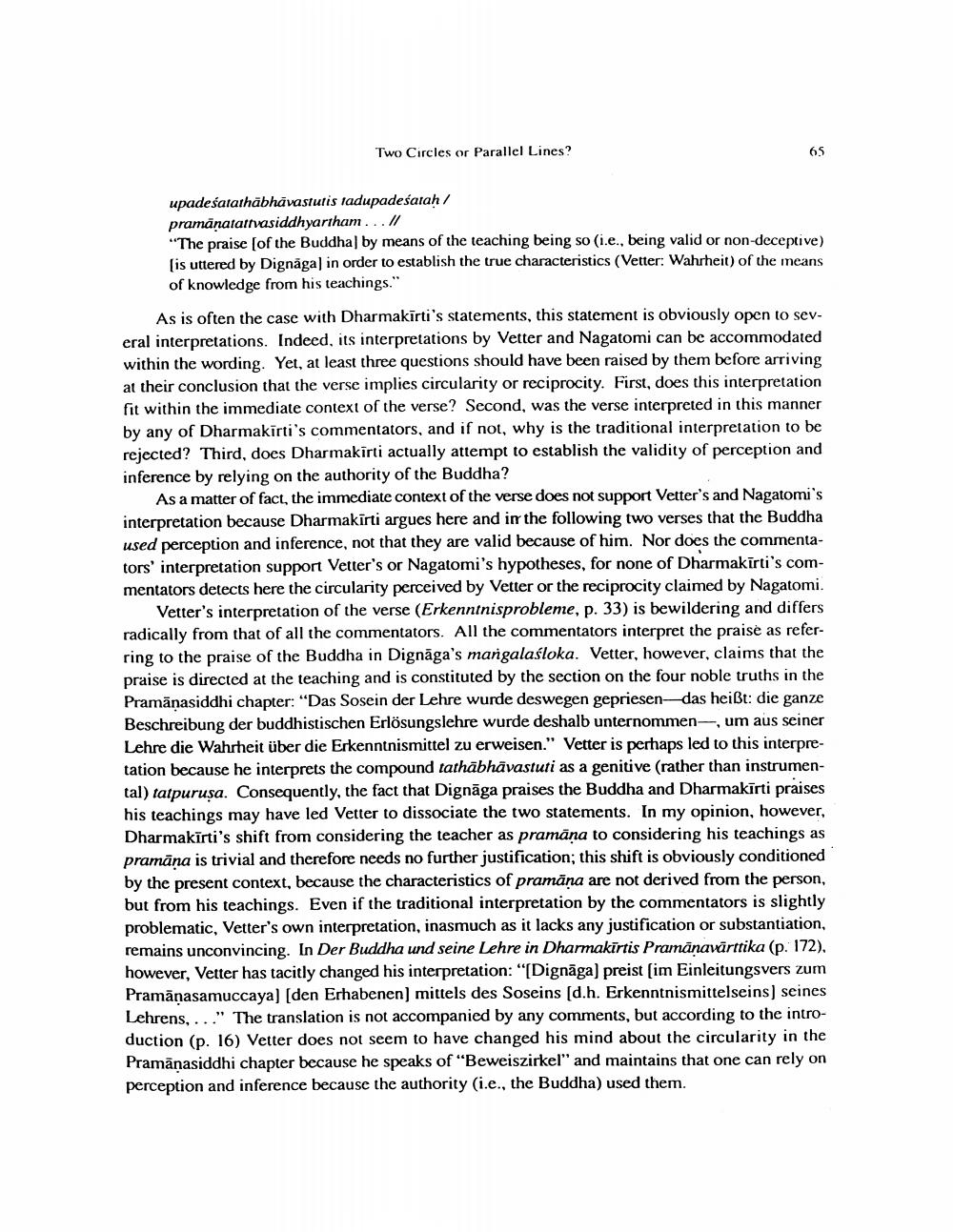Book Title: Two Circles Or Parallel Lines Author(s): Eli Franco Publisher: Eli Franco View full book textPage 3
________________ Two Circles or Parallel Lines? upadeśatathābhāvastutis iadupadeśatah / pramanatattvasiddhyartham... // "The praise fof the Buddha) by means of the teaching being so (i.e., being valid or non-deceptive) (is uttered by Dignāga) in order to establish the true characteristics (Vetter: Wahrheit) of the means of knowledge from his teachings." As is often the case with Dharmakīrti's statements, this statement is obviously open to several interpretations. Indeed, its interpretations by Vetter and Nagatomi can be accommodated within the wording. Yet, at least three questions should have been raised by them before arriving at their conclusion that the verse implies circularity or reciprocity. First, does this interpretation fit within the immediate context of the verse? Second, was the verse interpreted in this manner by any of Dharmakirti's commentators, and if not, why is the traditional interpretation to be rejected? Third, does Dharmakirti actually attempt to establish the validity of perception and inference by relying on the authority of the Buddha? As a matter of fact, the immediate context of the verse does not support Vetter's and Nagatomi's interpretation because Dharmakirti argues here and in the following two verses that the Buddha used perception and inference, not that they are valid because of him. Nor does the commentators' interpretation support Vetter's or Nagatomi's hypotheses, for none of Dharmakīrti's commentators detects here the circularity perceived by Vetter or the reciprocity claimed by Nagatomi. Vetter's interpretation of the verse (Erkenntnisprobleme, p. 33) is bewildering and differs radically from that of all the commentators. All the commentators interpret the praise as referring to the praise of the Buddha in Dignāga's mangalasloka. Vetter, however, claims that the praise is directed at the teaching and is constituted by the section on the four noble truths in the Pramänasiddhi chapter: "Das Sosein der Lehre wurde deswegen gepriesen das heißt: die ganze Beschreibung der buddhistischen Erlösungslehre wurde deshalb unternommen , um aus seiner Lehre die Wahrheit über die Erkenntnismittel zu erweisen." Vetter is perhaps led to this interpretation because he interprets the compound tathābhāvastuti as a genitive (rather than instrumental) tatpurusa. Consequently, the fact that Dignāga praises the Buddha and Dharmakirti praises his teachings may have led Vetter to dissociate the two statements. In my opinion, however, Dharmakīrti's shift from considering the teacher as pramāna to considering his teachings as pramāna is trivial and therefore needs no further justification; this shift is obviously conditioned by the present context, because the characteristics of pramāna are not derived from the person, but from his teachings. Even if the traditional interpretation by the commentators is slightly problematic. Vetter's own interpretation, inasmuch as it lacks any justification or substantiation, remains unconvincing. In Der Buddha und seine Lehre in Dharmakirtis Pramānavürttika (p. 172), however, Vetter has tacitly changed his interpretation: "[Dignāga) preist (im Einleitungsvers zum Pramāṇasamuccaya) (den Erhabenen) mittels des Soseins (d.h. Erkenntnismittelseins) seines Lehrens, ..." The translation is not accompanied by any comments, but according to the introduction (p. 16) Vetter does not seem to have changed his mind about the circularity in the Pramāṇasiddhi chapter because he speaks of "Beweiszirkel" and maintains that one can rely on perception and inference because the authority (i.e., the Buddha) used them.Page Navigation
1 2 3 4 5 6 7 8 9 10
